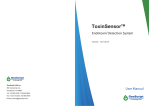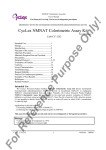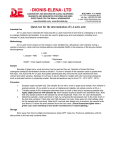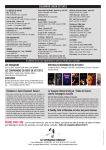Download ELISA Amp Sys 19589 14Jul08.qxd
Transcript
User Manual ELISA Amplification System Cat. No. 19589-019 Table of Contents 1. Notices to Customer .................................... 1 1.1 Important Information ........................... 1 1.2 Precautions .......................................... 1 2. Overview ..................................................... 2 3. Methods ...................................................... 4 3.1 Components......................................... 4 3.2 Storage ................................................ 4 3.3 Advance Preparations.......................... 5 3.4 Recommendations for Optimal Results ............................................ 6 3.5 ELISA Amplification System Protocol .......................................... 7 3.6 Color Measurement Assays ................. 8 3.7 Use of the Positive Control .................. 9 3.8 Factors Which May Affect Assay Results .............................. 10 3.9 Performance Standards .................... 13 4. Troubleshooting Guide .............................. 14 5. References ................................................ 15 i Table of Contents Figures: 1. Schematic of Alkaline Phosphatase Signal Amplification .............................. 3 2. Rate of Absorbance Increase as a Function of Total Incubation Time ...... 11 Table: 1. ELISA Amplification Versus pNPP in an Indirect ELISA ............................. 12 ii 1 Notices to Customer 1.1 Important Information This product is authorized for laboratory research use only. The product has not been qualified or found safe and effective for any human or animal diagnostic or therapeutic application. Uses for other than the labeled intended use may be a violation of applicable law. 1.2 Precautions PRECAUTIONS FOR USE. Warning: This product contains hazardous reagents. It is the end-user’s responsibility to consult the applicable MSDS(s) before using this product. Disposal of waste organics, acids, bases, and radioactive materials must comply with all appropriate federal, state, and local regulations. If you have any questions concerning the hazards associated with this product, please call the Invitrogen Environmental Health and Safety Chemical Emergency hotline at (301) 4318585. 1 2 Overview The ELISA Amplification System is designed to amplify the amount of color generated by a given quantity of immobilized alkaline phosphatase in a soluble substrate enzyme-linked immunosorbent assay (ELISA). In conventional detection systems, bound enzyme acts directly on the substrate to produce a colored end product. The signal generated by this type of system is limited by the linear nature of the reaction kinetics. In the ELISA Amplification System, the bound enzyme acts on a substrate whose product initiates a secondary cyclic enzyme reaction, resulting in a colored product. Each molecule of product from the first reaction takes part in many cycles of the second reaction; thus, the signal generated by the first enzyme reaction is amplified by participation of its end product in the cycles of the second reaction. The substrate in this system is the reduced form of nicotinamide adenine dinucleotide phosphate (NADPH), which is dephosphorylated by bound alkaline phosphatase to reduced nicotinamide adenine dinucleotide (NADH). NADH activates a secondary enzyme system which comprises a redox cycle driven by diaphorase and alcohol dehydrogenase. In this cycle, NADH, in the presence of diaphorase, reduces a tetrazolium salt (iodonitrotetrazolium violet or INT-violet) to form an intensely 2 colored formazan dye and is itself oxidized to form NAD+. NAD+ is then reduced to NADH and ethanol is oxidized to acetaldehyde in the presence of alcohol dehydrogenase. The rate of reduction of the tetrazolium salt is directly proportional to the concentration of NADH origin-ally formed by the enzyme in the bound conjugate. A schematic of the reaction is shown in figure 1. NAD+ Formazan* Ethanol Alcohol Dehydrogenase Diaphorase INT-Violet Acetaldehyde NADH Alkaline Phosphatase Pi NADPH *Colored end product Figure 1. Schematic of alkaline phosphatase signal amplification. 3 3 Methods 3.1 Components The components of the ELISA Amplification System are as follows. Each vial of substrate, substrate diluent, amplifier, and amplifier diluent contains enough reagent to perform two 96-well microtiter plate assays with the volumes suggested in the instructions. Each system provides reagents sufficient to perform 10 microtiter plate assays. Component Substrate (lyophilized NADPH) Substrate diluent (1X buffer for substrate) Amplifier [lyophilized amplifying enzymes (alcohol dehydrogenase and diaphorase) Amplifier diluent (1X buffer for amplifier) Positive control (streptavidin alkaline phosphatase conjugate (1 mg/ml) Amount 5 vials 60 ml (5 × 12 ml) 5 vials 60 ml (5 × 12 ml) 100 µl 3.2 Storage Upon receipt, the reagents in the ELISA Amplification System should be stored at 4°C. The substrate and amplifier are supplied lyophilized. After reconstitution, the amplifier is stable for 1 week at -20°C, and the substrate is stable for 8 days at 2-8°C. A slight pink color in the amplifier solution may develop during storage. This will not 4 affect the interpretation of results. 3.3 Advance Preparations The following reagents are required, but they are not provided with the system. Prepare them as follows: Final washing buffer/positive control diluent: Tris-buffered saline (TBS); 0.05 M TrisHCl (pH 7.5) and 0.15 M NaCl. This amount of buffer is sufficient for two 96-well plate assays. To prepare, add 1.51 g of Tris base (MW 121.14) and 2.19 g of sodium chloride (MW 58.5) to 230 ml of deionized water. Stir until dissolved. Adjust the pH to 7.5 with 2 M HCl. Adjust the volume to 250 ml with deionized water. Stop Solution: 0.3 M H2SO4. To 59 ml of deionized water, slowly add 1 ml of concentrated sulfuric acid (MW 98, specific gravity 1.84, purity 96% to 98%). Caution: When using sulfuric acid, exercise caution and follow manufacturer’s safety recommendations. When making dilutions, always add acid to water. 1. Bring all reagents, except the positive control, to room temperature before use. 2. Reconstitute the substrate at room temperature 10 min before use by adding 12 ml of substrate diluent directly to the substrate vial. Gently mix until completely dissolved, using clean pipets to avoid contamination. Do not leave uncovered. Reconstituted substrate is stable for 8 days at 2-8°C 5 Methods 3. Reconstitute the amplifier 10 min before use by adding 12 ml of amplifier diluent. Gently mix until completely dissolved, using clean pipets to avoid contamination. Do not leave uncovered. Reconsituted amplifier is stable for 1 week at -20°C 4. Dilute the positive control before use. Please read Section 3.7, Use of the Positive Control, for instructions. 5. Select a color measurement assay as described in the Section 3.6, Color Measurement Assays. 3.4 Recommendations for Optimal Results 1. Keep pipets and laboratory vessels used to dispense alkaline phosphatase conjugate and the positive control away from those used for other components, especially the substrate. 2. Minimize any nonspecific binding of antibody or conjugate by carefully washing the microtiter plate wells. Amplification reagents will amplify any nonspecific signal. 3. Avoid using phosphate in any wash buffer. It strongly inhibits the substrate reaction. 4. The substrate and amplifier reactions occur quite rapidly and require precise timing. To ensure equal incubation times in each well, add the substrate, amplifier, and stop solution in the same well-to-well sequence. 6 3.5 ELISA Amplification System Protocol N o t e : Please read the protocol thoroughly before beginning. Some of the steps in this procedure need to be performed simultaneously. 1. Perform a standard ELISA using alkaline phosphatase. Leave the last row of the microtiter plate empty at this stage for addition of the positive control. 2. Remove excess alkaline phosphatase by washing each well four times with 0.25 ml of TBS buffer (see Section 3.3, Advance Preparations). Wet the positive control wells with this buffer. Remove the fourth wash from all wells just before you proceed with the next step. 3. Add the positive control dilutions (see Section 3.7, Use of the Positive Control) to the last row of the microtiter plate. 4. Substrate: Add 50 µl of reconstituted substrate (prepared in advance) to each well, including the wells you have reserved for the positive control. Incubate for 15 min at 25°C. To increase sensitivity, extend the length of incubation, as described in Section 3.8, Factors Which May Affect Results. Amplifier: Add 50 µl of reconstituted amplifier (prepared in advance) to each well. Incubate for at least 15 min at 25°C, being careful not to cross-contaminate wells. Add amplifier and substrate in same sequence. 5. Measure the color development, using the assay method you have selected in advance. E n d p o i n t o r s t o p p e d a s s a y : Stop color development after 15 min with 50 µl of 0.3 M H2SO4 per well. Add the stop reagent in 7 Methods the same time sequence as the amplifier. Record the absorbance at 495 nm. Kinetic assay: Read the absorbance at 495 nm of each well every 3 min for 15 min. 6. To maintain the effectiveness of reconstituted substrate and amplifier for future use, store them immediately at 4°C. 3.6 Color Measurement Assays The following descriptions apply to measurement of color obtained in microtiter plate-based assays. However, the general principle is applicable to many systems employing a variety of reaction vessels. End Point or Stopped Assays. In this type of assay, color development is allowed to proceed for a predetermined time so that sufficient color develops in the test wells. Stopping the reaction, in effect halting any further cycling activity, is achieved by adding dilute acid. The stop solution must be added to the wells in a timed sequence identical to that used for the addition of substrate and amplifier. Assuming a reaction volume of 50 µl of substrate plus 50 µl of amplifier, 50 µl of acid will stop the reaction. Once all the wells have been stopped, the color can be quantified by reading with a suitable colorimeter at 495 nm. Kinetic Assays. In a kinetic assay, color development is not stopped, but read repeatedly over a period of time and the rate of color development calculated. Since cycling reactions show linear kinetics, rates of reaction can be 8 determined by plotting a regression line through the series of optical density measurements. The rates on the unknowns are then compared with the rates of standard samples. This method of reading also reduces problems which can occur with some multioptic readers from “channel-to-channel variation” in optical density. 3.7 Use of the Positive Control The positive control included with this system ensures that the components provided are performing properly. The positive control is alkaline phosphatase chemically coupled to streptavidin, a reagent used in many ELISA systems. When dilutions of the alkaline phosphatase conjugate are mixed with the amplifications reagents, color development occurs. The expected absorbance from each dilution will vary for each detector; however, the optical densities should decrease linearly as the control is diluted. The approximate concentration of alkaline phosphatase in the conjugate (before dilution) is 1 mg/ml. Therefore, final dilution in each well ranges from 1:4,000 (250 ng/ml) to 1:512,000 (~2 ng/ml) in two-fold increments per well. We recommend you reserve the last row of each assay plate for the positive control reaction, using 25 µl per well of serially diluted positive control. 1. Dilute the Positive Control 1:4,000 with TBS (see Section 3.3, Advance Preparations). 2. Transfer 50 µl of the diluted positive control to the first well of the last row in the microtiter plate. 9 Methods 3. Add 25 µl TBS to the remaining wells in the same row. 4. Transfer 25 µl from the well containing the positive control to the adjacent well in that row and mix. Transfer 25 µl from this well to the next adjacent well. Continue transferring 25 µl to adjacent wells until the last well in the row is used. Discard 25 µl from the last well. 3.8 Factors Which May Affect Assay Results Timing of Substrate and Amplifier Incubation of Steps. In the two-step amplifications process, both steps have linear reaction kinetics. In the first step (substrate incubation), the dephosphorylation of NADPH to produce NADH is terminated by adding the amplifier, which contains phosphate, in addition to the amplifying enzymes, and effectively inhibits the activity of alkaline phosphatase. In the second step (amplifier incubation), the rate of color production is proportional to the concentration of NADH produced in the first step. For a given amount of alkaline phosphatase, maximum sensitivity is achieved when substrate and amplifier incubations are of equal length (figure 2). Increasing the length of either incubation alone will increase the signal but to a lesser degree than equal length incubations. Length of Incubation. Incubation times for the amplification reagents can be varied depending on the sensitivity required. We recommend that you incubate each reagent for 15 min. This gives approximately a 10-fold increase in 10 1.4 Absorbance (495 nm) 1.2 1.0 1 0.8 2 0.6 0.4 3 0.2 10 20 30 40 50 60 70 80 90 100 Total Incubation Time (min) (Substrate + Amplifier) Figure 2. Rate of absorbance increase as a function of t o t a l i n c u b a t i o n t i m e . In line 1, substrate and amplifier incubation times are equal. In line 2, substrate incubation times were increased, while amplifier incubation times were held constant at 15 min. In line 3, substrate incubation times were held constant at 15 min, while amplifier incubation times were increased. sensitivity over the traditionally used substrate, pNPP, as demonstrated in table 1. If more (or less) sensitivity is required, incubation of both reagents for longer (or shorter) time periods can achieve the sensitivity required. It is important to maintain equivalent substrate and amplifier incubation times for optimal signal generation. If incubation times are increased, it is critical to minimize any nonspecific reactions during the ELISA procedure. 11 Methods Table 1. ELISA amplification versus pNPP in an indirect ELISA. Total Incubation Time of Amplification Reagents (min) Approximate Fold Increase in Sensitivity over pNPP 30 (15 for substrate 15 for amplifier) 10 45 (22.5 for substrate, 22.5 for amplifier) 15 60 (30 for substrate, 30 for amplifier) 20 90 (45 for substrate, 45 for amplifier) 30 Fold increase was determined by comparing the quantity of antigen that gave equivalent absorbances within the linear range of the detector. Antigen (purified rabbit IgG) concentrations ranged from 50 ng to 0.1 pg/well. All wells were incubated with optimal dilutions of Biotinylated Goat Anti-rabbit IgG, followed by Streptavidin-Alkaline Phosphatase Conjugate. The substrate, pNPP, was used at 1 mg/ml in 10% diethanolamine (pH 9.8), 0.5 mM MgCl2, and incubated for 60 min. Temperature. Because the amplification steps are enzymatic reactions, they are temperature dependent. For consistent results, we recommend that the amplification reagents be used at a constant temperature between 20°C and 25°C. Reagent Volumes and Concentrations. The signal may be strengthened by increasing the final assay volumes of the substrate and amplifier and, to some extent, by using a more concentrated amplifier. However, the reagents supplied with this system are paired, and we do not ensure the stability or performance of nonstandard volumes or concentrations. 12 3.9 Performance Standards The strength of signal and sensitivity of the ELISA Amplification System are routinely analyzed to ensure performance. We require the ELISA Amplification System to give maximal absorbance readings versus 10 ng of purified antigen within 30 min during the substrate and amplifier incubations. In addition, the system must be able to detect as little as 100 pg of purified antigen within the same timeframe. We measure these parameters in an indirect ELISA using optimal dilutions of biotinylated antibodies and Streptavidin-Alkaline Phosphatase Conjugate. 13 4 Troubleshooting Guide Problem Probable Causes High background Substrate not fresh. Substrate/amplifier incubated too long. Stop Solution omitted. Insufficient washing. Wash buffer too dilute. Contamination of substrate with phosphatase. Reagent too old or improperly stored. High level of nonspecific binding. Random high-absorbing wells Positive control splashed into other wells. Pipet tips contaminated with positive control. Insufficient washing. Completely red plate Weak color development in positive control Substrate/amplifier not properly dissolved or thoroughly mixed. Substrate mixed in a container which previously contained alkaline phosphatase. Incubation temperature of the assay too high or low. Substrate/amplifier incubation time too short. Incorrect preparation of substrate/amplifier. Substrate/amplifier not fully dissolved. Unexpectedly high, low, or variable absorbance readings Gross variation in signal Positive control omitted. Plate reader at wrong wavelength. Debris on bottom of wells. Bubbles in wells caused by inaccurate pipetting or incorrect preparation of substrate/amplifier. Inefficient removal of wash buffer. Inaccurate pipetting. Contaminated pipet tips. Incorrect preparation of substrate/amplifier. 14 5 References 1. Self, C.H. (1985) J. Immunol. Method. 76, 389. 2. Stanley, C.J., Johannsson, A., and Self, C.H. (1985) J. Immunol. Method. 83, 89. 15 Notes 16 Notes 17 Notes 18 United States Headquarters: Invitrogen Corporation 5791 Van Allen Way Carlsbad, California 92008 Tel: 1 760 603 7200 Fax: 1 760 602 6500 Email: [email protected] For country-specific contact information, visit our website at www.invitrogen.com Part No. 19589 Rev. Date: 14 July 2008





























